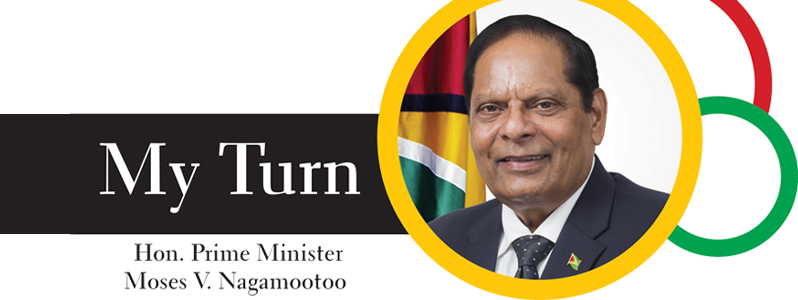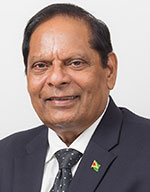I WELCOME toshaos and village leaders who, from tomorrow, will be attending the 12th National Toshaos Council Conference in Georgetown, and I wish them all the best as they focus on matters to promote the continuing story of development and transformation in the communities of our indigenous or First Peoples.
I had wanted to write this week about the exciting buzz that was ignited recently amongst Amerindian students when the first-ever Information and Communications Technology (ICT) Road Show touched down at Annai in the Rupununi. Now, with expansion of solar power to remote villages, young people could benefit from info hubs which would bring them new knowledge of technologies to modernise food production and marketing, and create jobs.
GANG OF EIGHT
But my attention was drawn to several requests from Facebook fans to say what is the “Gang of Eight”, to which I had referred in a previous column. As reluctant as I am to return to “party politics”, I decided to address those requests, especially after the parliamentary proceedings on Thursday and Friday last, which the opposition used as early public relations stunts to showcase the likely choice as the party’s presidential candidate for the next elections.
The “Gang of Eight” would eventually recommend that person who is being allowed media exposure and promoted as the premier parliamentary speaker on national issues in place of the opposition leader, who cannot now run. This is crude sponsorship that mocks at inner-party democracy, and shows that the “Gang of Eight” has taken an early jump.
As president, Bharrat Jagdeo had deployed this tactic, when he first pitch-forked Donald Ramotar to the top of a slate of potential candidates. I recall, sometime in late 2010, a protest by then senior party executive, Ralph Ramkarran, when the aspirant not only prematurely announced his candidacy, but was anointed as “Advisor to the President”. He was placed on the Guysuco board and was taken on presidential luxury rides to Kuwait, China, India and elsewhere.
MAJORITARIAN CONCEPT
The “Gang of Eight” could have been a majoritarian political concept, but in the absence of a strong leader, it became a weapon of manipulation and control. In the post-Jagan period, there was an obsession with manipulating political processes. Some leaders were not allowed access to lower party bodies, and were vilified by Moscow-trained “Marxist-Leninists” as liberals and social democrats. The fight for a place on the 35-member Central Committee degenerated into character assassinations.
The party’s structure is that the congress of delegates would elect 35 persons to sit on the Central Committee. Those 35 members, in turn, usually a week after congress, would meet to elect a 15-member Executive Committee. In my case, having emerged at the Top Two with the highest numbers of votes at the 1998 congress, a simple majority of 18 members voted against me. I was removed from the Executive Committee, after being continuously a member for 20 years. I had openly denounced my exclusion as “Stalinist”, reminiscent of the purges that took place under the Russian communist dictator.
The idea is to sanitise the Executive Committee, by making sure that a simple majority of eight out of the 15 members would support the “maximum leader”. The built-in majority would be decisive in a situation where the Executive Committee had to “recommend” a person or persons to be a presidential candidate.
In short, the “Gang of Eight” is a political concept that represents group loyalty and bloc support for a leader, or for preferred political decisions from time to time. The “Gang of Eight” numerically represents a majority where the decision-making body comprises 15 persons. The persons are not fixed, and could rotate from time to time, depending on whether or not he/she is seen as loyal. The “gang” is like a revolving door.
IDEOLOGICAL DIFFERENCES
Historically, leaders were thrown out from the party’s inner core, mainly due to tactical/strategic shifts and ideological differences, but the persons who were purged were invariably branded “opportunists”. From the early years of the PPP, there was expulsion of “ultra-left deviationists” like Martin Carter, Rory Westmaas and Sydney King (later Eusi Kwayana). That was followed by expulsion of “right opportunists” like L.F.S. Burnham and Jai Narine Singh, even though what has been described as a “split” emanated from more complex factors than just differences between hard-lined communists and moderate socialists.
In the 60s, the right-wing/leftwing contradictions became manifest in the contest between the fire-brand Communist Brindley Benn and Balramsingh Rai, the rightwing “Rajput”. It was then that Dr. Fenton Ramsahoye, famously consoled Rai, by observing that “the party works in devious ways”.
But there have also been “lefty-left” fallouts. Benn, who had declared that “it is easier to stop tomorrow than to stop communism”, and was perhaps, together with Boysie Ramkarran, loyal Jaganites, was to leave the PPP. He was deemed a “Moaist”, and he later formed the Working People’s Vanguard Party (WPVP). Another known “leftist”, Moses Bhagwan, was expelled and formed the Indian People’s Revolutionary Associates (IPRA).
FOUNDER-LEADER
Another of the great progressives, Ashton Chase, departed sometime after 1969 when the PPP formally joined the Moscow-controlled International Communist Movement. I may never know all the reasons why Ashton Chase left, but he remains respected and revered, and he stands tall above the political fray that has consumed so many worthwhile patriots and leaders. Having shared my first public meeting with him in 1964, at Liverpool on the Corentyne Coast, for me, he remains affectionately “the Founder-Leader”.
Today, I hear similar description of Jaganites as ”Old guards” and “spent”, well ahead of another anticipated purge.
The biggest upset was caused not by “left-right” deviations, but as a result of advocacy by some of us for PPP-PNC talks. I was a strong advocate for talks and rapprochement between Cheddi Jagan and Forbes Burnham, which resulted in a rearguard rump inside the party crudely rigging the PYO elections in 1976 in an effort to oust Halim Majeed, his brother Zaheer, Odeen Ishmael and myself. Cheddi Jagan ordered that the ballots be taken to his house, and we were reinstated in the leadership.
BIGGEST EXODUS
It was then that the biggest exodus of leftwingers took place from the PPP, led by the pro-Moscow, Marxist-Leninist ideologue Ranji Chandisingh and included, later, pro-Cuban Marxists Vincent Teekah and Lallbahadur Lalbachan. Almost the entire corps of Moscow-trained communists defected to Burnham’s PNC.
The fallouts occurred mainly as a result of failure of the inner-party political processes to handle political/ideological and sometimes personality differences. That was the reason I was foremost in my advocacy to broaden the shoulders of the party to avoid one-man dictatorship and to cleanse the party of reliance on unacceptable practices to entrench a “Gang of Eight”.
But the quest for personal power had become insatiable, and it would continue to devour some of the finest intellectuals and progressive leaders this country has produced. In the post-Jagan PPP, political life could be cruel, brutal and short!
July 15, 2018



.jpg)








